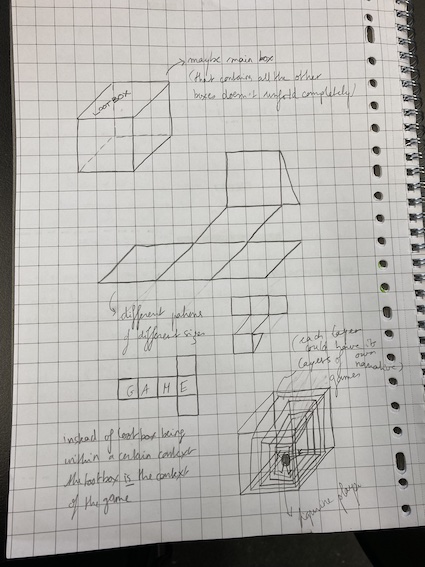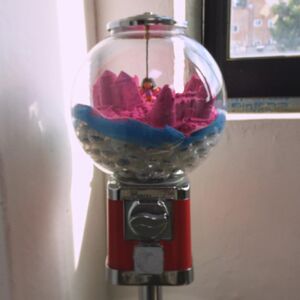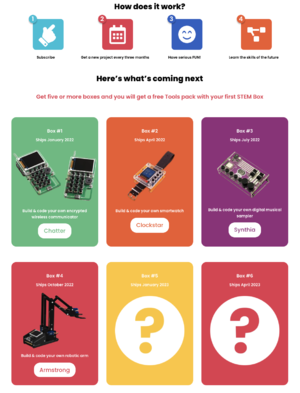Future Loot Box: Difference between revisions
| Line 210: | Line 210: | ||
Focus on the fanfic/game format, each game has its own narrative, and the public has the agency of creating its own character in this narrative. <br> | Focus on the fanfic/game format, each game has its own narrative, and the public has the agency of creating its own character in this narrative. <br> | ||
There could also be multiple loot boxes with a same outside and different narratives within each (maybe a variant of 6 or so?) focus on the box format. <br> | There could also be '''multiple loot boxes''' with a same outside and different narratives within each (maybe a variant of 6 or so?) focus on the box format. <br> | ||
Instead of the lootbox being within a certain context, the loot box is the context for the games | Instead of the lootbox being within a certain context, the loot box is the context for the games | ||
Revision as of 11:34, 16 February 2022
Classic Loot box
Definition
Etymology
The origin of the word 'loot':

early 19th century (as a verb): from Hindi lūṭ, from Sanskrit luṇṭh- ‘rob’.
How it works
History of the loot box
The first actual loot box system is believed to have been the Gachapon ticket. It was included in the Japanese version of the side-scrolling MMORPG MapleStory, which was launched in 2004. Each ticket was sold for 100 Japanese yen (0.75 euro). Players would use the in-game booth Gachapon to swap their tickets for game items.
[1]
This early model of loot bow was based on the Gacha machine and the price was fairly low. A more manipulative, monetized loot box model is considered to be the free-to-play 2007 Chinese game ZT Online.
https://static.wikia.nocookie.net/ultimatepopculture/images/b/b9/Overwatch_loot_box.gif/revision/latest/scale-to-width-down/350?cb=20190823131234
Highly Recommend to read this page: >>>>https://ultimatepopculture.fandom.com/wiki/Loot_box<<<<
Notes from wikipedia for defining loot boxes
Loot boxes are seen by developers and publishers of video games not only to help generate ongoing revenue for games while avoiding drawbacks of paid downloadable content or game subscriptions, but to also keep player interest within games by offering new content and cosmetics through loot-box reward systems.
Loot boxes are often given to players during play, for instance as rewards for leveling up their character or completing a multiplayer game without quitting.
Loot boxes may also be given out through promotions outside of gameplay, such as watching certain streaming events.
Players can also buy them directly, most often with real-world funds but also through in-game currency (sometimes, in-game currency can or has to be paid for with real-world funds to obtain lootboxes).
The items that can be granted by a loot box are usually graded by "rarity", with the probability of receiving an item decreasing rapidly with each grade.
In some redemption processes, yet-revealed items are presented with a colour that corresponds to its rarity level, further heightening the excitement of revealing the items.
Characteristics of loot box
- cost (you pay for it)
- exclusivity (time frame to obtain it)
- collectionable (you can have more)
- surprise mechanism
- further additional investment
- creates a certain final fantasy/desire
- gambling? (investment will not probably come back, anticipation)
- exploitative
- addictiveness
- reward
Special Issue 17 Loot box
Our Definition
The definition of Loot box depends on:
- a) the definition of classic loot box
- b) what we want to subvert from a)
- c) our message
- d) ...
How it works
This will depends on our definition of Loot box / our message /
One-sentence loot boxes
- Loot box with ideas to subvert the loot box
- A loot box that brings out a random theory/ideology connected to gamification and explains it in a fun way
- A loot box that brings out a random statement/s (from those we created, as each of us can add as many as they want) about loot boxes & productive play we wrote/illustrated and explains it; and points to a collected reader
- Loot box with lyrics inside, each box brings one song and when you open it you can go at a karaoke webpage and sing it
- Loot box that holds more games inside
- An inverted loot box
- A reversed/semordnilap loot(tool) box
- A loot box tool box
- A loot box that can be deconstructed and reconstructed
- A loot box that becomes a poster/book when is unfolder/folded differently
- Tiny lucky charm paper loot boxes
- A piñata loot box (but not candy inside)
- A time capsule loot box
- A loot box that you need to build by yourself
- A loot box that contains the last page of all the books in a book store
- A loot box to be closed
- A loot box to be sealed
- A loot box that cannot be opened alone
- Loot box as a decorator
- Loot box as a skin
- A loot box that follows you around
- A loot box that is a portal to another loot box (loop box)
Ideas
Temporality of the loot box
The loot box implies a specific temporal dimension: the one with instant rewarding. When a player opens the loot box she receives immediate feedback. Sometimes it is dressed up with an aesthetic of suspense, but this is just cosmetics and the built-up climax often becomes just something undesired that the user wants (and even pay) to skip.
In order to work with the idea of the loot box without re-enacting its toxic behavior and mechanics it could be interesting to hijack its temporality. By inflating the time between the purchasing and the result, we could create space for dig deeper in this complex and delicate topic.
note:
This reminds me of Reciprocity that I bumped into the other day filling out the glossary for our SI17.
It would be interesting to play with time for this SI 17, the question is how?
Loot box
pay ●-->○ get
SI17 Loot Box
pay ●---------things could happen here--------->○ get
This approach could help us in filling the loot box (tempo) without falling for the same addictive schemes that the industry is implementing for exploiting the players.
Inflating the loot box means that the player could reclaim her own leisure time. If we focus on the temporal fruition of the l~b we can imagine to produce not only an object, but a time slot that the person from the public can reserve for herself. If we define this time slot as leisure time then we could create a sacred and safe space to take a rest and to arrest the acceleration of capital. Something like a checkpoint, speaking from a gaming point of view.
An approach to deal with the temporal aspect in a way that doesn't feel forced could be to rely on real-yet-slow-time processes for the material production of the special issue.
More about this on the Soupboat
LOOT—BOX—SEALING—DEVICE
imagine the loot box being 3D printed, and especially 3D printed on demand when the player want to buy it at Page Not Found or Varia or any other place we are going to distribute our work. 3D printing is a slow process, and in order to create a small piece you need to wait let's say an hour. When someone want to buy our loot box goes to PNF and ask for it, the 3d print begin and during the waiting time the player can access and navigate through the contents of our special issue. These contents are contained inside the temporality of the l~b, but they are not consumed instantaneously.
How do we want to deliver these contents? It could be related to the way of production of the physical l~b, for instance each player could contribute and shape the 3d model for the next player during the waiting time, and we can aggregate and collect narrations within and around the tools used in order to do so.
In order to cover the expenses of a similar process part of the SI17 budget could cover the cost for some small 3D printers and printing material. The term of services of our special issue could allocate a certain amount of money from each purchase to self sustain the process (buying new printing material, etc)
(I would like to elaborate more on this!) (I'm sorry I'm such a living stereotype white cis male talkin about 3d printers forgive me)
more about this on the SOupbpat
things to keep in mind to subvert the loot box
Games are computational systems, games are PLAYABLE THEORY (make theory playable)
they succeed because they explain really complex systems/issues/challenges in an easy way
REMEMBER: our loot box is made of content and mechanics --> think about the environment around the loot box + what's inside 1.content inside the box
2.outside part of the box
3.environment around the box
point at the power relations of society and destroy them
take reality and exaggerate a but not make it too unreal
are games not the space to talk about social issues?
--> take a blackboard and write down all the features and characteristics of the loot box to be able to SUBVERT IT
can we create a game to play the game and get the loot box? --> see kamo's idea
a. every game is a representation of a real-world system; made to explain really complex systems/issues/challenges in an understandable and simplified way (synthesising aspect)
. "make theory playable"
b. theory of a system: what are the artefacts that the game is representing?
extract some elements to represent
c. using symbols or stereotypes to attract the audience to the loot box and then sneak in with what's the meaning, trolling the user
- additional thoughts on the temporality of the loot box:
.gain access to the work
.make the work to be done in order to get the loot box already valuable in the act itself
- further questions on the existence of the loot box
what is the context? what's the game around the loot box?
try to upsell something that the customer is already interested in
gambling feature to be subverted
think about the degree of political engagement of your public
For example: the McDonald game looked like other existing management games: it looks like something simple, an official game, but it includes sneaky ways to deepen into the topic --> using symbols or stereotypes to attract the audience to the loot box and then sneak in with what's the meaning, trolling the user.
regulations to subvert the loot box
what if we create some regulations to follow in order to have access to the loot box, rules that are the opposite of what a loot box generally does?
the idea is --> create a SAFE environment around the moment in which the user will open the loot box.
Like an API, an example of the moment in which the person has received the loot box and has it in their hands:
from the outside, the loot box is really nice, but after you get in you can't go on opening unless you follow the regulations imposed by the loot box.
- outside label?
hello dear user, we want to congrats you on choosing this amazing loot box! you have done the best choice and we imagine you cannot wait to see what will happen inside.
a. after reading the welcoming letter, the user opens the loot box (with inside different closed packages/boxes/idk what
b. inside he will find another box (or many little ones or idk yet) ( + i am a lot into the idea of game in a game in a game in a game so can't really get rid of it eheh surry) where there will be another letter for the user: "find a nice spot that makes you feel relaxed, take a deep breath, look around, feel the breath, and now enjoy the surprise"
c. another box: "you are allowed to open this box just in presence of some friends (or random people you'd like to share this with !! here to remember not everyone has close friends to share things with therefore find a sentence to make it doable for everyone)
d. another box: "we recommend opening this box during a sunny day"
---to be continued
A box in a box in a box is a loot box
The loot box Matrioshka!

A box in a box in a box is a loot box, like patron of boxes, rules included (or not) on one of the sides, game on the rest —> players/public could 3D print their character figurine that would lie in the centre of the boxes and could be used to play the games, for multiplayer games, the several box owners could share boards with their character figures.
Focus on the fanfic/game format, each game has its own narrative, and the public has the agency of creating its own character in this narrative.
There could also be multiple loot boxes with a same outside and different narratives within each (maybe a variant of 6 or so?) focus on the box format.
Instead of the lootbox being within a certain context, the loot box is the context for the games
-> remains the surprise element, chance to progress in a game (without needing additional investment), the choreography for opening it (agency of unraveling product).
Other notes:
- Loot box as a secret box, in order to open the loot box to access (very physical) items or digital items, public has to unlock the box themselves, they have full agency as to unravel the content of the loot box, not only tied to a monetized exchange

- Instead of delivering additional items to the public, as lootbox do to entice you in getting more more and more, your investment is a one time buy, and what is delivered to you is not a feature but a collection of whole games. The loot box delivers game, the loot box is not a predatory feature within games.
- The loot box as a winning feature. To purchase the loot box is to win the game. Every time one acquires a loot box one is given a congratulation message which sends them back to the start. In such way, in order tone able to navigate and enjoy the game, the player has to avoid picking up loot boxes.
Pricing of the loot box
Mothers & Daughters, a pop-up bar in Belgium
"At Mothers & Daughters we use a pricing system that tries to address the documented gender gap in Belgium. (...) If you have a privileged position that means your wages, and access to opportunities and documented work are positively affected by your gender, sexuality and/or ethnicity, then choose menu B.
For the rest of us, because of our sexuality, ethnicity and/or gender we choose menu A."
https://www.mothersanddaughters.be/about
Caffè sospeso
Italian for "suspended coffee" or pending coffee is a cup of coffee paid for in advance as an anonymous act of charity. The tradition began in the working-class cafés of Naples, where someone who had experienced good luck would order a sospeso, paying the price of two coffees but receiving and consuming only one. A poor person enquiring later whether there was a sospeso available would then be served a coffee for free.
Network Imaginaries
This book can only be bought by 2 or 10 units at a time...
https://www.hackersanddesigners.nl/p/Network_Imaginaries_Publication
Multiplayer loot box
If the public of the classical loot box is made of individuals that are easier to exploit, our SI17 could research on ways to generate relations within the public.
The classical loot box assumes two main things: 1. That the public is an homogeneous group of individual users 2. That the relation between the loot box and its public should be always the same
Starting an analysis and making open questions for defining the world of our loot box
analysis
A loot box contains objects that create a desire but this desire only makes sense inside the world of a particular game. In the the other way around, the loot box is desirable, because it provides you with specific objects that makes you progress inside a game.
- the materiliaty of the desire for a loot box
- the objects inside of it that make you progress in the game
- the process of conquering it or
- the exciting surprise for finding it by chance
- the choreography for opening it
- that it is a reward, a positive reinforcement
- that it is exclusive or rare
The game designer decides the way that someone is going to obtain a loot box
1.Loot boxes are often given to players during play, for instance as rewards for leveling up their character or completing a multiplayer game without quitting.
Gamers work their way to get a loot box through their devotion to the game.
2.Loot boxes may also be given out through promotions outside of gameplay, such as watching certain streaming events.
Gamers as fans devote their time in events outside of the game, they get the loot box as a reward.
3.Players can also buy them directly, most often with real-world funds but also through in-game currency.
Gamers as addicted consumers that purchase the loot box with real money.
general idea
By creating a loot box we are going to appropriate a hegemonic object, a profit mechanism inside a video game that make players keep interest -and in the worst case senario get addicted- to that game.
lootbox inside a scenario
Starting from the premise that lootboxes are a catchy and tricky response to the desire of progression, of expansion of agency, of richness in a game, I want to reflect on how lootboxes are 1) a system for the management and distribution of resources and 2) objects that strategically build a system of meaning and a world/scenario around themselves in order to legitimize that same desire and use it as a fuel to keep going on. Lootboxes are an immediate acquisition of resources that allow or contribute the progression in the game. In this way they're strictly related to the world they are part of, and they are consistent with it; not only in terms of aesthetics, but also for the specific affordances the items inside lootboxes bring to the main character/player. F.e. a lootbox that gives you a magic sword, cannot make sense in the real world, and the desire of it only make sense in a scenario in which that same sword helps you to more easily reach your objective in the gameplay... (magic circle..?)(what item can be useful in real life?)
Designing a lootbox means designing the context and the world around it. or at least it means to intervene in the existing context in which the lootbox is purchased: What does it mean to purchase a lootbox in the context of xpub? and in the context of Page not Found? and in the context of a mainstream commercial bookstore? Which kind of tools are we proding our public with? which kind of world/scenario are these tools talking about and how their use affect this scenario?
I want to be mindful about the use value of our lootbox: where do we position it in the tension between existing use-values (mostly dictated by a capitalistic system that wants to make profit) and other-use-values (originated by creating a context around our lootbox that doesn't follow the logic of profit) is it the use-value what triggers the desire for purchasing a lootbox? can we think of other values that can trigger desire? if play/leisure stress on the uselessness of activities (and time) I think this should be an important point to keep in mind.
suggestion: would it be useful to map the kind of affordances that items inside lootboxes bring? either with a more historic approach and a more speculative one
other suggestions:
I was triggered by the previous text we had to read, when it was talking about skins and personalised interface mods: it would be nice also to think at the lootbox not only in terms of an object, but also in terms of switch of perspective
for example:
you open a lootbox and you are another character, and there are things that you can do or that you have access to in the gameplay only if you have a specific character
or. the lootbox is a skin that you put on things, an interface that gives meaning to the contents of the special issue in a particular way idk I have to elaborate more on this
About the scenario:
We need to define what qualities of the world that we live in constitute our game world. We know that it is going to be selled in the PNF and we are going to have a launch there. But why our public will be getting rewarded with a loot box?
Who is our public?
What are the characteristics of our public?
What do they desire?
Maybe we should consider the different identities of our public and their different occupations. For example, in a video game a human male football player desires different loot than a female elf warrior.
Also, PNF can be a cultural space inside our game world and not the game world itself. A part of the system of our game world. As it is in real life, it is a cultural space within a city and a city is part of a country that have certain rules, values, working conditions and legislations, gender roles, ethnicity roles, dominant ideologies and power dynamics etc.
and this can go on and on...
or/and it can conncect PNF with other systems
So for me in order to engage better on what will be our loot box, I think it is important to decide what is the story that our public is going to play in?? For example:
Do we want to talk about gamification in its different applications?
Working time and leisure time that depend on class, gender, ethnicity etc (interesctional approach)?
Because loot box is a reward mechanism inside a specific game-system. And our game design can expose or transcend the dominant ideologies of our (game) world. And it can be site specific connecting it with the dutch context. [or an intersectional context that we will define]
Examples of Lootboxes
- A small installation for the main video work, <Peachblend/피치블렌드 (2015)> by Korean artist and filmmaker Iida Choi. (The artist said there is no title for this artwork.) As more people insert a coin and get an item from the Gashapon(Gachapon) machine, the more the artwork(?) get destroyed. [NOTE] Strictly speaking, this may not be a loot box, but I thought this is an interesting approach. Making this act of buying/getting an item leads to destroying/damaging the sandcastle installed inside the box.
- Kibrit gift box (Bulgarian small business): a gift box that you can buy without knowing the content; each month it has new contents (bio cosmetics selection).
- Hoppipolla indipendent culture by mail (from Italy!)
- Ludobox by Catherine Lenoble
- time vs. money
- STEM box DIY electronics subscription "empowering kids and adults through hands-on STEM experience"





